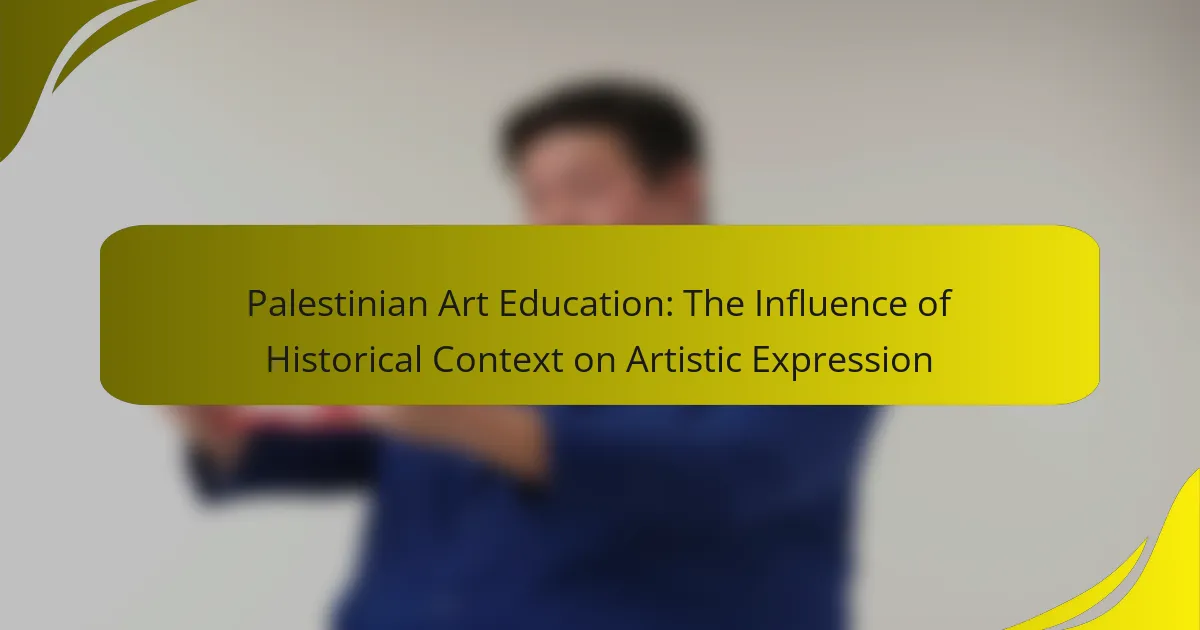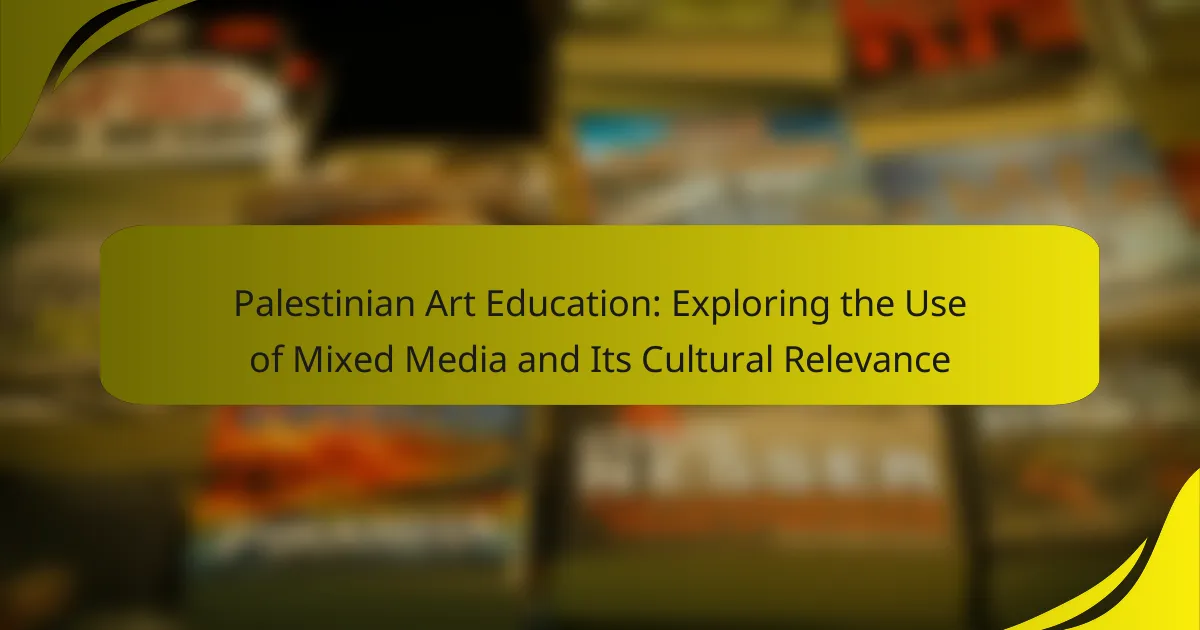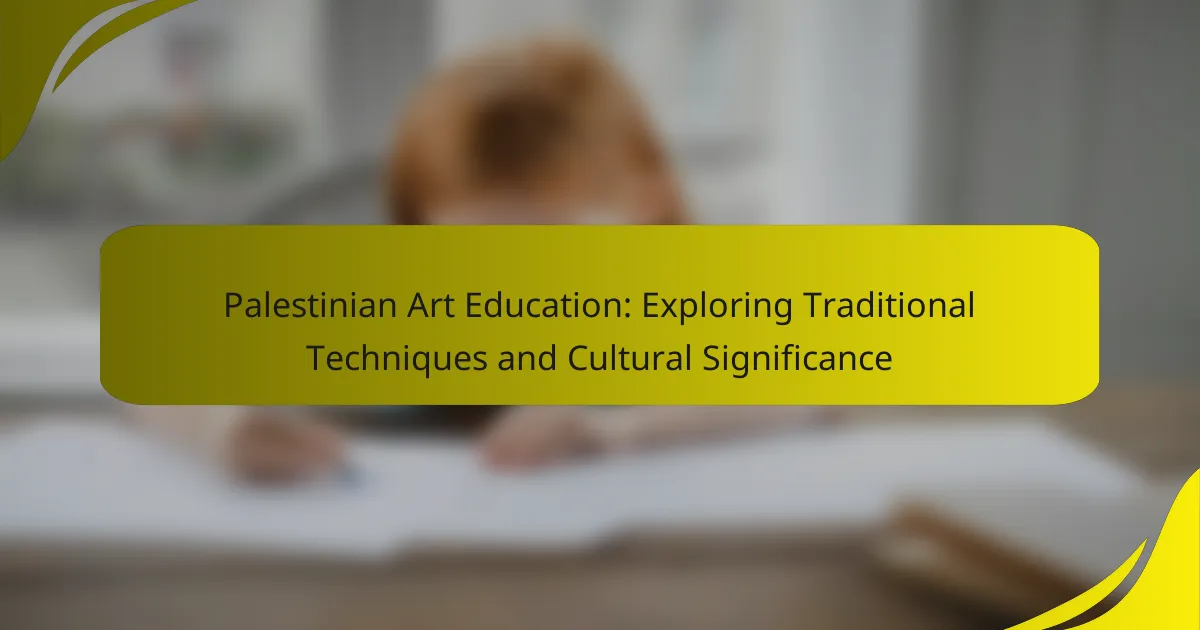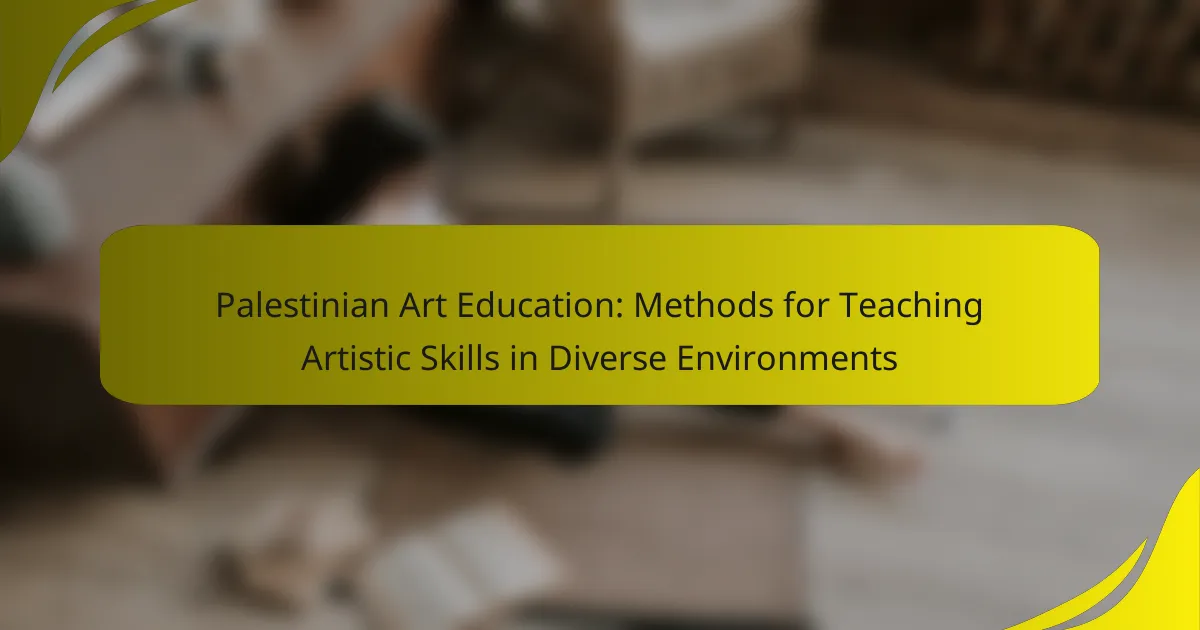Palestinian Art Education focuses on the artistic development of students in Palestine, encompassing visual arts such as painting, sculpture, and digital media. It aims to foster creativity, critical thinking, and a deeper understanding of Palestinian cultural and historical identity. Key components of this educational system include peer reviews, instructor critiques, and community exhibitions, which collectively enhance artistic growth and expression. However, educators face challenges such as limited resources, political conflict, and cultural sensitivities that impact the effectiveness of critique and feedback. This article examines the importance of art critique and feedback in the context of Palestinian Art Education and its role in student development.
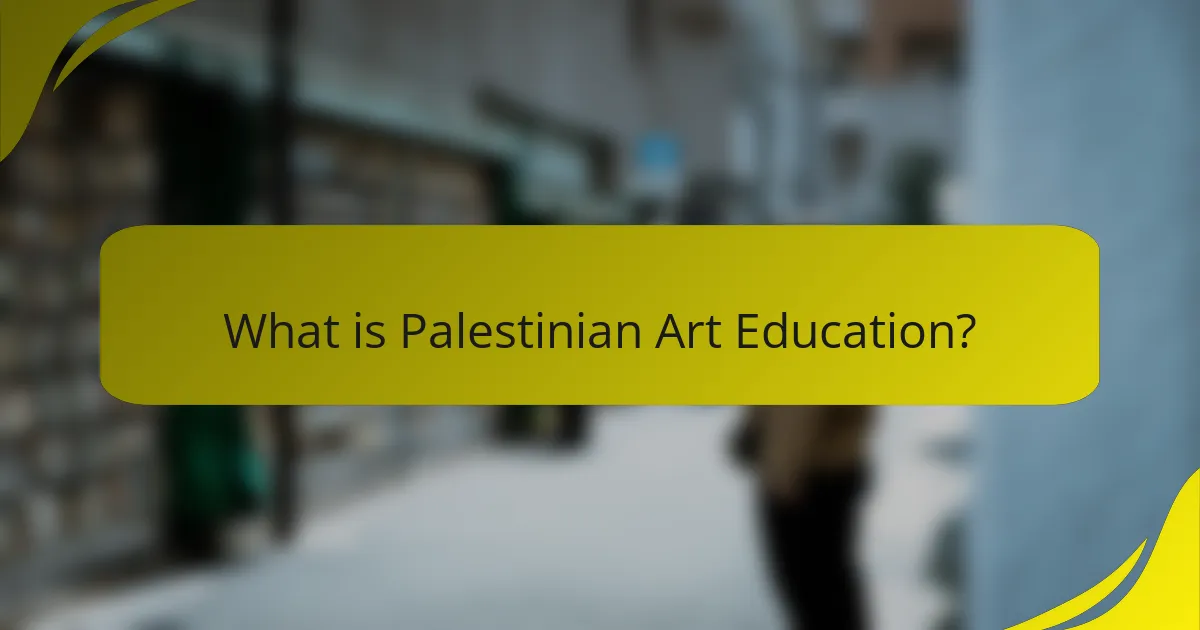
What is Palestinian Art Education?
Palestinian Art Education is a system of teaching that focuses on the artistic development of students in Palestine. It encompasses various forms of visual arts, including painting, sculpture, and digital media. This education aims to foster creativity and critical thinking among students. It also emphasizes the cultural and historical context of Palestinian identity. Programs often incorporate local traditions and contemporary issues. Institutions such as universities and community centers provide these educational opportunities. Palestinian Art Education plays a crucial role in personal and social expression. It supports the development of a unique artistic voice in a challenging environment.
How does Palestinian Art Education differ from other art education systems?
Palestinian Art Education emphasizes cultural identity and political context more than many other art education systems. It integrates local history and social issues into the curriculum. This approach encourages students to express their experiences and perspectives through art. In contrast, other systems may focus primarily on technical skills and global art movements. Palestinian art education often incorporates community engagement and activism. This fosters a sense of responsibility among students towards their society. Additionally, the unique challenges faced by Palestinian artists influence their creative expression. This context shapes the educational experience, making it distinct from more conventional art education frameworks.
What cultural influences shape Palestinian Art Education?
Palestinian art education is shaped by a blend of historical, social, and political influences. The ongoing conflict and occupation have significantly impacted artistic expression and education. Traditional Palestinian culture, including folklore and crafts, also plays a vital role in shaping art education. Additionally, global art movements and diaspora experiences introduce diverse perspectives. Institutions like the International Academy of Art Palestine promote contemporary practices while honoring cultural heritage. These influences create a unique educational environment that fosters resilience and identity through art.
How does the historical context impact art education in Palestine?
The historical context significantly impacts art education in Palestine. Ongoing conflict and political instability shape the educational landscape. Limited resources affect access to art materials and facilities. Cultural identity plays a crucial role in art curriculum development. The influence of traditional Palestinian art forms is evident in student projects. Historical narratives inform the themes explored in art education. Furthermore, community engagement often drives artistic expression and education. This context fosters resilience and creativity among students.
What role does art critique play in Palestinian Art Education?
Art critique is essential in Palestinian Art Education as it fosters critical thinking and self-reflection among students. It encourages students to analyze their work and the work of others, promoting a deeper understanding of artistic concepts. This process enhances their ability to articulate their thoughts and feelings about art. Art critique also creates a dialogue between students and instructors, facilitating constructive feedback. Such feedback helps students refine their techniques and develop their unique artistic voice. Furthermore, critique sessions often address cultural and political contexts, enriching students’ perspectives. Overall, art critique plays a crucial role in nurturing well-rounded artists in Palestine.
Why is art critique essential for student development?
Art critique is essential for student development because it fosters critical thinking skills. Through critique, students learn to analyze their work and the work of others. This process encourages self-reflection and personal growth. Students gain the ability to articulate their thoughts about art clearly. Constructive feedback helps them identify strengths and areas for improvement. Engaging in critique also builds confidence in their artistic voice. Research shows that students who participate in critiques demonstrate enhanced creativity and problem-solving abilities. Overall, art critique is a fundamental practice that supports holistic student development in the arts.
How does art critique foster critical thinking among students?
Art critique fosters critical thinking among students by encouraging them to analyze and evaluate artwork. This process involves assessing various elements such as composition, technique, and meaning. Students learn to articulate their thoughts and support their opinions with evidence. Engaging in discussions promotes deeper understanding and reflection on artistic choices. Research shows that critique sessions develop analytical skills essential for problem-solving. A study by B. R. H. Hargreaves and A. J. Galton indicates that art critique enhances cognitive development in educational settings. Overall, art critique cultivates a mindset of inquiry and evaluation in students.
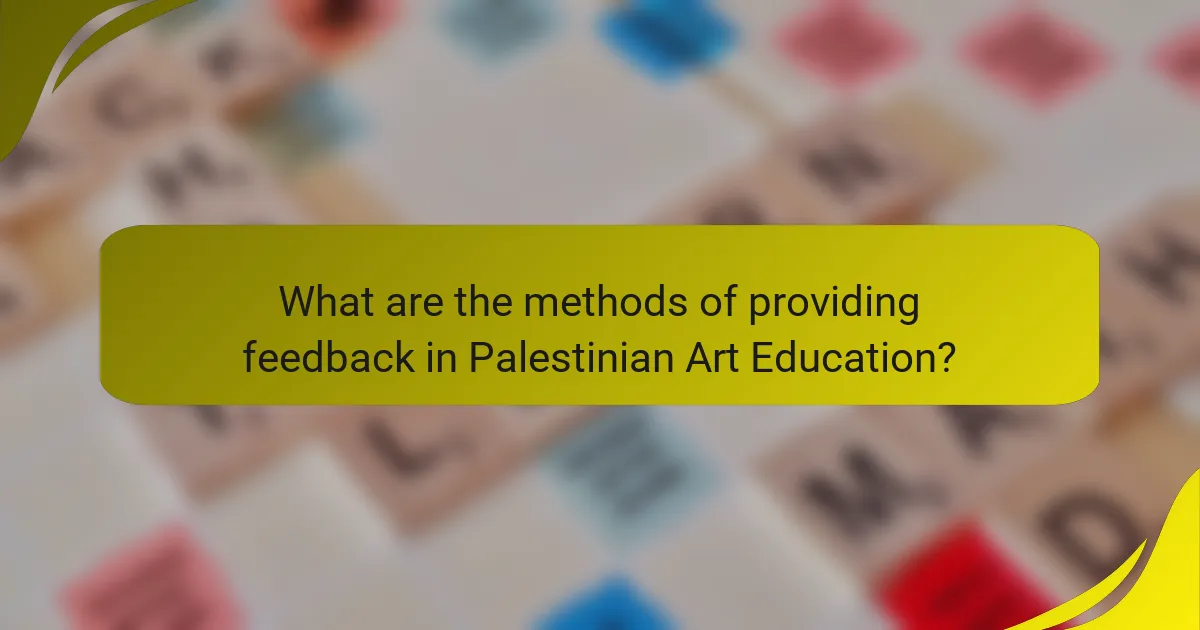
What are the methods of providing feedback in Palestinian Art Education?
Methods of providing feedback in Palestinian Art Education include peer reviews, instructor critiques, and community exhibitions. Peer reviews allow students to evaluate each other’s work, fostering collaboration and constructive criticism. Instructor critiques provide expert guidance and personalized insights on students’ artistic development. Community exhibitions enable public feedback, offering diverse perspectives on student artwork. These methods collectively enhance learning and encourage artistic growth.
What types of feedback are commonly used in art critiques?
Common types of feedback used in art critiques include formal, informal, and constructive feedback. Formal feedback often involves structured evaluations based on specific criteria. Informal feedback can be spontaneous comments made during discussions. Constructive feedback aims to provide actionable suggestions for improvement. Each type serves to enhance the artist’s work and development. Research shows that effective feedback can significantly influence artistic growth. According to the National Art Education Association, critiques promote critical thinking and self-reflection among students.
How do formative and summative feedback differ in this context?
Formative feedback is ongoing and focuses on improving student skills during the learning process. It provides insights that help students understand their strengths and areas for growth. In contrast, summative feedback is evaluative and occurs at the end of an instructional period. It measures student learning against established criteria. Formative feedback supports continuous development, while summative feedback assesses overall achievement. This distinction is crucial in Palestinian art education, where constructive critique fosters artistic growth and summative evaluations validate student progress.
What role does peer feedback play in student learning?
Peer feedback enhances student learning by promoting critical thinking and self-reflection. It allows students to engage with their peers’ work and provides diverse perspectives. This interaction fosters a collaborative learning environment. Research shows that students who receive peer feedback improve their understanding of concepts. A study by Topping (1998) found that peer assessment can lead to higher academic achievement. Additionally, peer feedback encourages communication skills and builds confidence in students. It also helps students develop the ability to critique constructively. Overall, peer feedback is a vital component in the learning process.
How can feedback improve artistic skills in students?
Feedback can significantly enhance artistic skills in students by providing constructive insights. It helps students identify strengths and weaknesses in their work. This process encourages self-reflection and critical thinking. Feedback also fosters a growth mindset, motivating students to improve. According to a study by Hattie and Timperley (2007), effective feedback can lead to a 30% increase in student performance. Regular feedback sessions enhance skill development by promoting ongoing dialogue between instructors and students. This interaction creates a supportive learning environment, essential for artistic growth.
What specific skills are enhanced through effective feedback?
Effective feedback enhances critical thinking, communication, and self-assessment skills. Critical thinking improves as students analyze feedback to refine their work. Communication skills develop through articulating responses to feedback and engaging in discussions. Self-assessment skills are enhanced as students reflect on their strengths and weaknesses based on the feedback received. Research indicates that constructive feedback fosters a growth mindset, encouraging students to embrace challenges and learn from mistakes. This process ultimately leads to deeper learning and artistic development.
How does constructive criticism contribute to artistic growth?
Constructive criticism enhances artistic growth by providing valuable feedback on an artist’s work. It helps identify strengths and areas for improvement. This type of feedback encourages self-reflection and critical thinking. Artists can refine their techniques based on specific suggestions. Moreover, constructive criticism fosters resilience and adaptability in an artist’s practice. Research indicates that receiving feedback can lead to increased creativity and innovation. Artists who embrace constructive criticism often develop a deeper understanding of their craft. This process ultimately contributes to their overall artistic development and success.
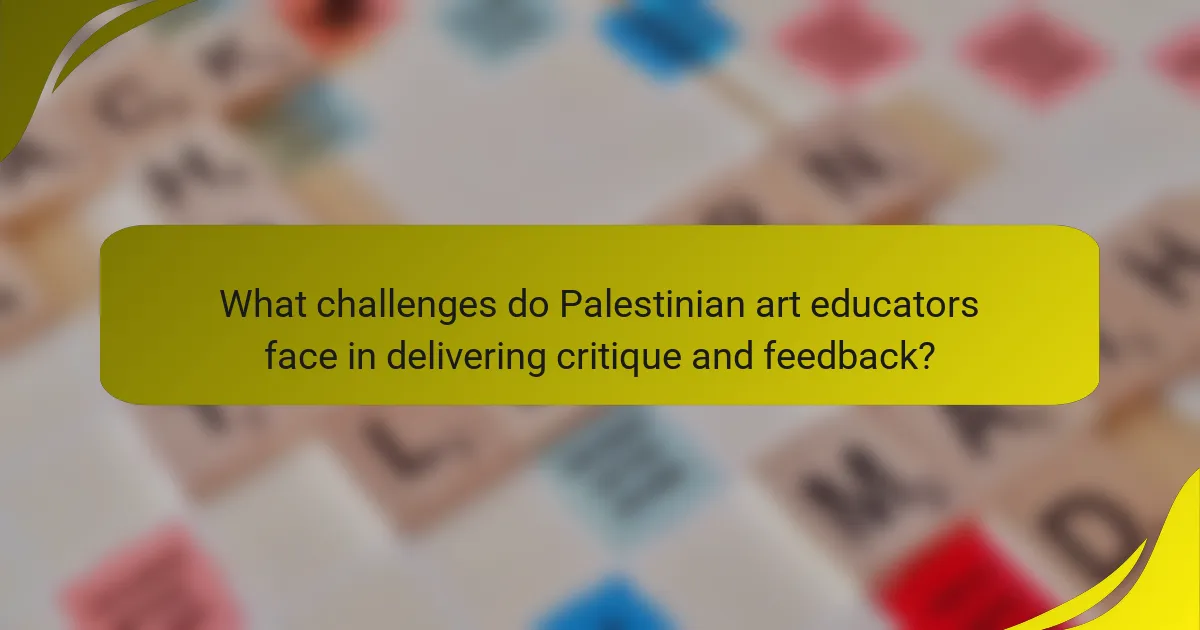
What challenges do Palestinian art educators face in delivering critique and feedback?
Palestinian art educators face significant challenges in delivering critique and feedback. These challenges include limited resources and funding for art programs. The ongoing political conflict restricts access to materials and safe spaces for education. Cultural sensitivities around expression further complicate open critique. Educators often fear repercussions for discussing certain themes. Additionally, there is a lack of professional development opportunities for teachers. Many educators struggle with balancing constructive feedback with emotional support. The overall educational environment can hinder honest dialogue about artistic growth. These factors collectively impact the effectiveness of art education in Palestine.
What external factors affect the art education system in Palestine?
The art education system in Palestine is affected by several external factors. Political instability significantly impacts the resources available for art education. Restrictions on movement hinder access to educational institutions and materials. Economic challenges limit funding for art programs and supplies. Cultural influences shape the curriculum and artistic expression. International collaborations can enhance opportunities for students. Global trends in art education also influence local practices. These factors collectively shape the landscape of art education in Palestine.
How do socio-political issues impact art critique practices?
Socio-political issues significantly influence art critique practices by shaping the context in which art is created and evaluated. These issues affect the themes artists choose to explore, often reflecting societal struggles or political statements. For instance, in regions experiencing conflict, such as Palestine, art can become a medium for resistance and identity. Critiques in this context may focus on how effectively the artwork communicates these socio-political narratives.
Additionally, socio-political dynamics can alter the perspectives of critics. Critics may approach art with a heightened awareness of cultural sensitivity and political implications. This awareness can lead to a more nuanced evaluation of artworks that address complex social issues. Research shows that critiques in politically charged environments often prioritize the artist’s intent and the work’s impact on social consciousness.
In summary, socio-political issues shape both the content of art and the criteria by which it is critiqued, emphasizing the importance of context in art evaluation.
What resources are lacking for effective art education in Palestine?
Palestine lacks essential resources for effective art education. Key deficiencies include limited access to quality art materials and tools. Many schools do not have sufficient funding for art supplies. Furthermore, there is a shortage of trained art educators in the region. This impacts the quality of instruction and mentorship available to students. Additionally, inadequate facilities hinder practical art experiences. Many educational institutions lack dedicated art spaces or studios. These shortcomings restrict students’ ability to explore and develop their artistic skills.
How can educators overcome these challenges?
Educators can overcome challenges in Palestinian art education by implementing structured art critique sessions. These sessions encourage constructive feedback among peers. Educators should provide clear guidelines to facilitate effective discussions. Incorporating diverse perspectives can enrich the learning experience. Training educators in art critique techniques enhances their ability to guide students. Research shows that peer feedback improves artistic skills and confidence. Consistent practice in critique fosters a supportive learning environment. Ultimately, these strategies can lead to improved student development in the arts.
What strategies can be implemented to improve art critique methods?
Incorporating structured frameworks can enhance art critique methods. Implementing specific criteria for evaluation promotes clarity. Encouraging peer feedback fosters diverse perspectives. Utilizing visual aids can illustrate points effectively. Offering workshops on critique techniques builds confidence. Establishing regular critique sessions creates a routine for practice. Providing written feedback alongside verbal comments ensures comprehensive understanding. These strategies align with educational best practices, as studies show structured critiques improve student engagement and learning outcomes.
How can collaboration with international art communities enhance local practices?
Collaboration with international art communities can enhance local practices by introducing diverse perspectives and techniques. This exposure fosters innovation in artistic expression. Local artists gain access to global networks and resources. They can participate in international exhibitions and workshops. Such engagement elevates the visibility of local art on a global stage. It also encourages cross-cultural dialogue and exchange of ideas. Collaborative projects can lead to the sharing of best practices in art education. Evidence shows that artists involved in international collaborations often report increased creativity and skill development.
What best practices can enhance the effectiveness of art critique in Palestinian Art Education?
Best practices that can enhance the effectiveness of art critique in Palestinian Art Education include fostering a supportive environment for open dialogue. This encourages students to share their perspectives without fear of judgment. Incorporating structured critique sessions helps to guide discussions and maintain focus. This structure can include specific criteria for evaluation, which provides clarity and consistency.
Utilizing peer feedback promotes collaborative learning. Students learn from each other’s insights and develop critical thinking skills. Providing clear examples of effective critiques can serve as a model for students. This can include showcasing successful artworks and discussing what makes them effective.
Encouraging self-reflection is also vital. Students should assess their own work and articulate their creative processes. This practice deepens their understanding of their artistic choices. Lastly, integrating cultural context into critiques enriches discussions. This relevance helps students connect their work to their identity and experiences.
These practices collectively enhance the critique process, leading to more meaningful artistic development in Palestinian Art Education.
How can educators create a supportive environment for critique?
Educators can create a supportive environment for critique by fostering open communication. Encouraging students to express their thoughts without fear of judgment is essential. Establishing clear guidelines for respectful feedback promotes constructive dialogue. Incorporating peer reviews in the curriculum allows students to practice giving and receiving critiques. Providing examples of effective critique helps students understand expectations. Regularly checking in with students about their comfort levels can enhance the environment. Creating a culture of collaboration rather than competition encourages participation. Research shows that supportive critique improves student confidence and artistic growth.
What tools can be used to facilitate effective feedback sessions?
Tools that can facilitate effective feedback sessions include digital platforms, structured templates, and interactive workshops. Digital platforms like Google Docs enable real-time collaboration and commenting. Structured templates guide the feedback process, ensuring consistency and clarity. Interactive workshops encourage open dialogue and peer-to-peer feedback. These tools enhance communication and promote a constructive feedback culture. They have been shown to improve student engagement and learning outcomes in educational settings.
Palestinian Art Education is a teaching system aimed at fostering artistic development within the context of Palestinian culture and identity. This article explores the unique aspects of Palestinian Art Education, emphasizing the role of art critique and feedback in enhancing student development. Key topics include the cultural influences shaping the curriculum, the importance of constructive criticism for artistic growth, and the challenges faced by educators in delivering effective feedback. Additionally, it discusses methods for improving critique practices and the impact of socio-political factors on art education in Palestine.
